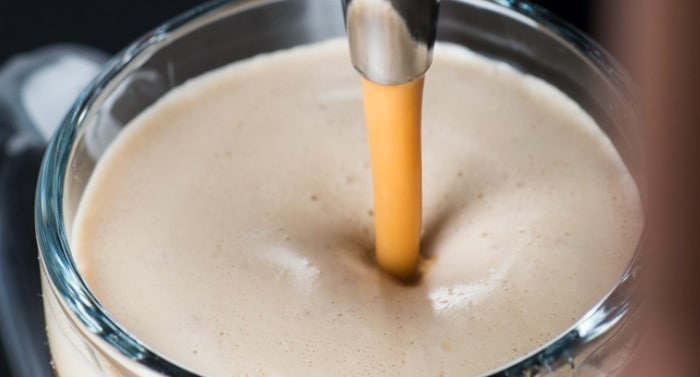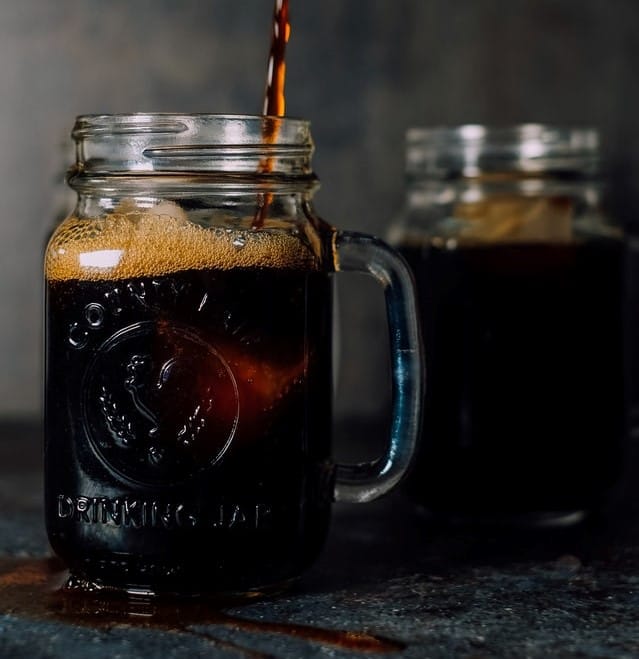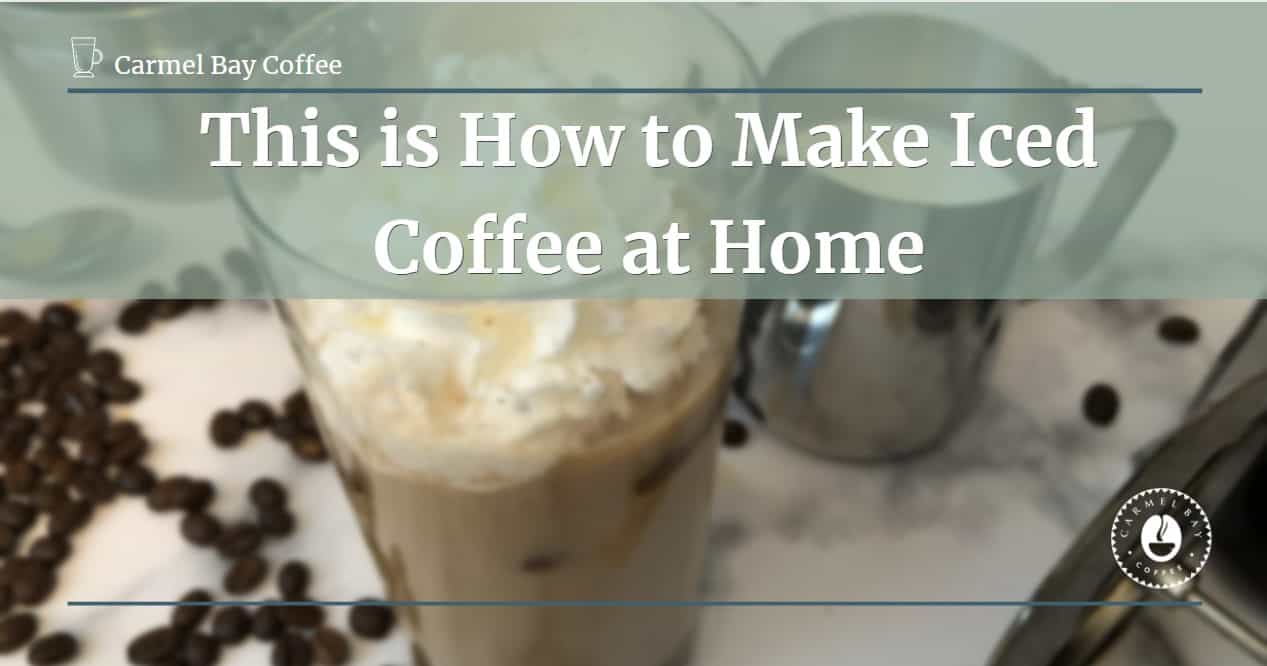A few years ago, cold-brewed coffee took over the iced coffee market, bringing us big flavor and a whole lot of caffeine. Folks love cold brew for its chocolatey notes, full-bodied texture, and propensity for high caffeine content.
Cold-brew can be pricey when you’re at the cafe every day and, while we always want to support our local cafes, we can support our local roasters (and save a little cash!) when we brew our own cold brew at home.
What Is Cold Brew Coffee?

What exactly is cold brew coffee, and how is it different from iced coffee? Cold brew is coffee brewed using cold or room temperature water over an extended period. In contrast, iced coffee can be made in a variety of ways using hot water.
Iced coffee can be made hot and put in the fridge to cool down over an hour or two; it can be made at a concentrate and brew directly over iced – also known as flash brew, or it can be made hot and flash chilled using a unique cooling system.
Aside from the brewing method, the significant difference between cold brew and iced coffee is its flavor and texture. Iced coffee tends to carry a lighter, brighter flavor profile and is a smooth, silky tea-like consistency. Cold-brew delivers a richer, darker flavor profile and presents as a thicker, more concentrated beverage.
In the end, it’s up to your own personal taste – both methods bring us delicious coffee!
What Equipment Do I need for Cold Brew?
You probably have everything you need already. I’ve used my French press as it has a filter built in. I’m not really able to make a large batch all at once, so it’s nice to have dedicated piece of equipment to make larger batches of cold brew.
With the immersion cold brew (I’ll get into the drip method down below), you can make consistent cups of coffee. You also don’t have to tie up your French press all day.
Check out BTaT full immersion cold brew coffee maker. This can brew 64oz of coffee at a time, and will provide a smooth, non-bitter taste of coffee.
What About Nitro Cold Brew?
Nitro Cold Brew is practically a whole other product on its own! Nitro cold brew takes regular cold brew and adds a little something extra – nitrogen! Flavor-wise, nitro cold brew creates a creamy texture and boosts the vanilla and milky flavors present in the otherwise chocolatey and nutty cold brew.

Cold-brew is nitrogenated using a tank of food-grade nitrogen hooked up to a keg of regular cold brew. The nitrogen is pumped into the keg of cold brewing, pushing any remaining oxygen out of the keg, and integrates with the cold brew by pushing tiny nitrogen bubbles throughout the keg.
These bubbles are what create the fantastic texture that nitro cold brew offers.
Are you interested in getting nitro cold brew at home without installing an entire tap system, purchasing kegs and tanks of nitrogen? No worries – grab yourself a whipped cream canister and throw your cold brew in the canister along with the appropriate nitrogen capsule and let her rip! Nitro cold brew at home, in small batches, of course.

You can also buy cans of nitro cold brew. Check out all the options and flavors here.
How Does Temperature Effect the Brewing Process?

Temperature is critical when it comes to brewing coffee. Folks swear by specific temperatures for specific brew methods, but professionals tend to accept 195-205 degrees Fahrenheit as the industry standard for most brew methods (automatic drip, pour-over, immersion).
However, cold brew stands along in that it requires room temperature or cold water, generally sitting between 55 and 75 degrees Fahrenheit. A tremendous leap from the almost boiling temperatures of brewing hot coffee.
Water temperature while brewing controls what flavors are extracted from the coffee, in what quantity those flavors occur, as well as the quality of taste.
Boiling water can burn the coffee and create bitter, unpleasant flavors.
This is why hot brewing requires water about 7-17 degrees of boiling (212 degrees Fahrenheit). The hot water extracts various flavors from coffee, and it does so quickly, generally between 30 seconds (espresso) and 4 minutes for some pour-over methods.
Coldwater can extract many flavors from coffee, but it does not pull the same variety as hot water, nor does it take so little time. Brewing coffee cold tends to extract more deep and mellow flavors rather than the bright and sometimes acidic flavors that hot brewing extracts.

Many folks enjoy cold brew because of its mellow flavors and tendency to stay away from higher acidity experiences. Both have their pros and cons and are simply different methods with different outcomes – neither is better or worse than the other!
However, due to its temperature, cold brewing requires much more time than hot brewing. At a minimum, cold brewing requires around 10 hours to extract coffee flavors properly. It will often be brewed for up to 18 hours. This is due to the quantity of coffee being brewed as much as the desired flavor outcome.
The more coffee being brewed, the longer the brew time in general. The longer the coffee is brewed, the more dark and rich flavors are extracted, whereas the shorter the brew time, the more bright and light flavors are extracted.
How Does Grind Size Effect Cold Brew?

Grind size has a considerable effect on the flavor and brewing process for any method. Like water temperature, cold brewing and hot brewing methods differ considerably with grind size. A general rule to follow is that the shorter the brew time, the finer the grind. Likewise, the longer the brew time, the coarser the grind.
Following that logic, espresso is a concise brew method (30 seconds or so) and requires an extremely fine grind; pour-overs take about 3-4 minutes and require a medium grind; cold brew takes 10-18 hours and requires a very coarse grind.
The finer the grind, flavors are extracted faster and in greater quantities, so, to avoid extract too much flavor too quickly, cold brew utilizes the coarsest grind possible.
This allows the coffee to slowly brew during the 10-18 hours required for cold brewing coffee.
Does it Matter if I Used Pre-Ground Beans for Cold Brew?
It may seem like a small thing, but it’s important to know if you used pre-ground beans for cold brew or not. The reason is that the grounds have less surface area than whole beans, and the flavor will be more intense. If you are using ground coffee for iced coffee, then this doesn’t apply to you because most people use coarsely ground coffee anyway.
Typically the pre-ground coffee you buy at a store is the coarsely ground variety.
If you like your coffee strong, then it’s best to grind beans fresh for cold brew. You’ll have more control if you use a grinder.
If not, pre-ground is perfectly fine for hot, iced, or poured over ice coffee as the concentration in flavor is less intense unless you’ve made ice cubes with coffee the day before.

Just make sure that if you use preground coffee, there is more than enough water and time to steep properly, so the grounds don’t end up being too intense in taste.
This may seem obvious, but many people assume all coffees have been finely grounded regardless of whether it was packed whole bean or put through a mill before packaging. Pre-ground coffee you’d get at the store is going to be made for a drip coffee machine.
There is no one right answer on this topic because everyone has different preferences with their afternoon cold cup of joe, ranging from a strong cup to a milder cup.
It is up to each individual to decide what they prefer and how much flavor they want. There are those that like a stronger, robust taste, while others might enjoy something lighter with less impact on their palate. The best way to find out which you would prefer is by tasting different coffee made with different grind sizes until you discover the one for you!
Remember, part of being a coffee enthusiast is getting to try out new methods and approaches to making coffee!
Pre-Ground Beans for Cold Brew: Pros & Cons
- You can save time because you don’t have to grind beans ahead of time.
- If you use it with a French press, the ground coffee may stop some sediment from going into your cup.
- It’s not as fresh or flavorful if using pre-ground beans instead of whole beans. The texture is also heavier and clumps together more easily when making cold brew
If you’d like to go deeper into this subject, I have an entire article dedicated to it here. This Is How Often To Grind Coffee Beans.
How To Get More Control Over Your Grind?
The best way of having totel control over your grind is by only buying whole beans and grinding them at home. This will accomplish two things:
- You’ll have control over your grind for every coffee brewing method. Different methods have different grind size requirements, i.e., a French press will require coarser, larger coffee grounds than espresso, while will need very fine grounds.
- You’ll always have the freshest coffee. Whole coffee beans last longer than pre-ground coffee. You can make your coffee last weeks longer and taste better if you switch to grinding at home.
Theirs two type of grinders you should consider. Burr or Blade coffee grinders.
Which is better, a burr or blade coffee grinder? Burr grinders have been around longer and they produce a more uniform particle size which will give you an even extraction.
Blade grinders use the principle of centrifugal force to chop up your beans into small pieces so that they can be evenly ground by rotating blades. Which type of coffee grinder should you buy? It depends on what flavor profile and strength that you prefer in your coffee drink!
I use to use a blade grinder but they don’t get full control over your grind. If you’re not sure which type of grinder to get, I would recommend a burr coffee grinder. Burr grinders are more expensive than blade, but you might end up buying a burr grinder anyways when you want more control over your coffee grounds.
The above picture is the burr grinder that I use. I did a ton of research and decided on this one because it wasn’t outrageously priced while still performing well. If you want to see all the features, you can check that out here.
If you’d like to see the price comparison between blade and burr, this is the blade grinder I’ve had for years.
Immersion Cold Brew vs. Drip Cold Brew
Throughout this article, we have been referring to and discussing immersion cold brew as our primary method. However, another cold brew method exists and is often featured in storefronts of cafes and roasters due to its aesthetically pleasing design.
Drip Cold Brew is very different from Immersion Cold Brew in quick a few ways. The most obvious being the visual aspect. Drip cold brew is done in much smaller batches and tends to look like a beautiful science experiment; meanwhile, immersion cold brew is brewed in large batches and often resembles a large container of brownie batter.
Other than aesthetics, we did mention that drip cold brew is done in smaller batches. This is due to the design of the dripper and its function. Ice cold water is slowly dripped onto a bed of coarsely ground coffee and then, even more slowly, trickles through the coffee and a filter into the container below.
Drip cold brew uses gravity to force the water through the coffee bed. The process takes about 3-5 hours – much shorter than immersion cold brew – and yields a brighter and more acidic (in a good way!) coffee beverage than the 10-18 hour immersion cold brew. This is due to the time of exposure to water that the coffee undergoes.
For home brewers, the most significant difference is the price tag. Drip cold brewers range from $30 to $300. Immersion cold brew is practically free – all you need is a jar and a filtering agent (cheesecloth, paper filter, sieve) or a French press, like I mentioned earlier.
If you are looking for a Dripper Iced Coffee Brewer, take a look at Soul Hands’ brewer here. It’s elegant-looking and has super fine control over the drip process.
Light, Medium, or Dark Roast?
I’ll cover light, medium, and dark roast here a little, but for a full breakdown and in-depth discussion, check out my article, Medium vs. Dark Roast Caffeine.
With light hot coffee, you can brew whatever you prefer! That being said, most roasters and cold brewers prefer a medium or dark roast – or somewhere in between the two.
This is due to cold brew’s tendency to elevate richer flavors, most frequently occurring in darker roasts. Light roast cold brew can be delicious, but light roasts tend to shine when brewed hot. Respectively, darker roasts tend to excel as cold brewed beverages.
Blends are a fantastic option for cold brew because they create a balance of flavor and help you avoid a flat-tasting beverage. Sometimes cold brew can create too much subtlety of flavor, and using a blend can help you brew a dynamic and delicious drink.
Our favorite cold brew options come from roasters all over! Check out our recommendations below:
Boundless Coffee Roasters, Colombia Patroness
Los Angeles craft coffee roaster, Boundless, offers a well-rounded and delicious single-origin that is the perfect fit for home cold brewers. Support a small business when you sip this balanced and sweet cup.
Onyx Coffee Lab, COLD BREW
Award-winning roaster, Onyx Coffee Lab, doesn’t mess around when it comes to cold brew. They’re putting out a blend specifically with cold brew in mind, and it sure shows up for it. We love this brew and think you will, too.
Stumptown, Hairbender
A classic option for cold brewing at home. Stumptown’s Hairbender blend is practically made for cold brewing. With a full and rich flavor, this cup includes a hint of sweetness.
New Harvest Coffee Roasters, Organic Kilimanjaro
Another standby for cold brewers nationwide is New Harvest’s Organic Kilimanjaro blend coming through with a hint of smoke, blueberry, and a whole lot of chocolatey goodness.
What’s the best coffee for cold brew? It might be a blend you haven’t created yet. Take full control over your coffee by learning how to blend coffee for cold brew. Check out my article, where you’ll learn how to blend coffee for the perfect cup!
Wrapping Up
Iced coffee and cold brew are both tasty but have different flavors. If you’re interested in experimenting with these drinks or want to know which is better for your tastes, try out the different coffee brands I’ve shared above!
We hope this article helped you learn more about what makes up each drink and gave some helpful tips on making them at home. Thanks for reading!
If you’re more interested in iced coffee due to its strong tastes, check out my article about making the best-iced coffee possible!






